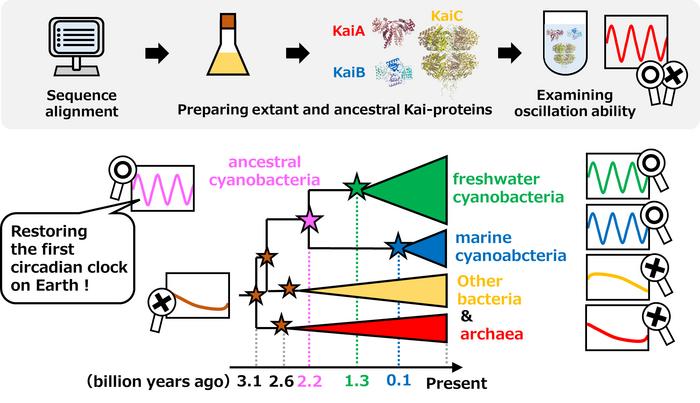In a groundbreaking study published in Nature Communications on May 15th, 2025, a Japanese research team has provided remarkable insights into the evolutionary history of circadian clocks in cyanobacteria, revealing how these ancient microorganisms developed molecular timekeeping mechanisms over billions of years. These findings not only illuminate the intricate biological rhythms at the core of life on Earth but also trace the ancient adaptation of these organisms to a planet whose rotation period itself evolved through cosmic time.
Cyanobacteria, also known as blue-green algae, are among the earliest known photosynthetic organisms that have profoundly influenced Earth’s atmosphere and biosphere. Their ability to perform oxygenic photosynthesis contributed to the Great Oxidation Event approximately 2.3 billion years ago, transforming the Earth’s atmosphere and enabling the proliferation of aerobic life. However, how these microorganisms synchronized their metabolic and physiological processes with the day-night cycle remained largely elusive. The research team set out to decipher the molecular evolution of the core circadian clock proteins—KaiA, KaiB, and KaiC—responsible for generating self-sustained oscillations essential for anticipating environmental cycles.
At the heart of the circadian clock in cyanobacteria lies the Kai-protein complex, which autonomously drives rhythmic phosphorylation cycles with a roughly 24-hour period. By reconstructing ancestral Kai proteins using reconstructed gene sequences and biochemical analyses, the team meticulously recreated ancient Kai protein oscillators in vitro, effectively rewinding over three billion years of molecular evolution. This approach allowed them to directly probe the biochemical properties and rhythmic behaviors of these primordial timekeeping components.
Their analyses revealed that the earliest forms of the KaiC protein lacked the sophisticated conformational and functional properties necessary for sustained oscillations. Instead, these ancestral proteins exhibited faster, less stable rhythms corresponding to cycles between 18 and 20 hours. This finding intriguingly matches computational and geological evidence suggesting that Earth’s rotation period was shorter in the distant past due to tidal friction and other geophysical phenomena. Thus, molecular clocks in ancient cyanobacteria appear to have been tuned to the planet’s changing day length, effectively preserving a biological record of Earth’s rotational evolution within their protein oscillators.
Around pivotal global events such as the Great Oxidation Event and the Neoproterozoic Snowball Earth glaciations, molecular evolution endowed the Kai proteins with increased structural complexity and stability. These adaptations gradually enhanced the oscillator’s precision and self-sustaining characteristics, culminating in a 24-hour period that matches modern Earth’s rotation. The team’s biochemical reconstructions suggest that the selective pressure to align biological rhythms with environmental light-dark cycles was a key driver in refining the circadian machinery, ensuring maximal photosynthetic efficiency and metabolic homeostasis.
Understanding how ancient cyanobacteria evolved a circadian oscillator capable of enduring through Earth’s dramatic environmental shifts sheds light on the fundamental principles of chronobiology and molecular evolution. The intertwined evolution of life’s internal clocks and Earth’s planetary cycles exemplifies the profound coupling between biology and geophysics. The study’s comprehensive use of molecular phylogenetics, protein biochemistry, and biophysical characterization provides a compelling narrative linking molecular innovation to planetary history.
Moreover, these findings offer exciting implications for synthetic biology and astrobiology. The researchers envision harnessing this knowledge to engineer modified cyanobacteria with tunable circadian cycles, potentially enabling photosynthetic microorganisms to optimize energy capture on planets or satellites with rotation periods vastly different from Earth’s 24-hour cycle. This could revolutionize strategies for bioengineering organisms adapted to extraterrestrial environments, playing a crucial role in future space exploration and the quest for life beyond Earth.
The research was spearheaded by scientists including Atsushi Mukaiyama, Associate Professor at Fukui Prefectural University, and Yoshihiko Furuike, Assistant Professor at the Institute for Molecular Science, whose expertise in molecular evolution and chronobiology brought vital interdisciplinary perspectives. Collaborators from Nagoya University, Osaka University, and SOKENDAI enriched this multidisciplinary effort, supported by prestigious funding from AMED, Takeda Science Foundation, and others.
Employing the cyanobacterial strain Synechococcus elongatus as a modern framework, the team utilized advanced molecular biology techniques to express and purify both extant and ancestral Kai proteins. These proteins were reconstituted into oscillatory systems in vitro and subjected to rigorous functional assays, including phosphorylation state monitoring through time-resolved biochemical methods. Structural analyses complemented these experiments, elucidating the molecular changes that underpin the emergence of robust rhythms.
The evolutionary trajectory outlined in this work underscores how incremental molecular changes can yield profound functional innovations, enabling organisms to adapt to planetary-scale environmental cycles. This research thus bridges the microscopic world of protein dynamics with macroscopic geophysical phenomena, enriching our understanding of life’s adaptability over geological epochs.
The revelation that molecular oscillators within ancient cyanobacteria contain imprints of Earth’s rotational history heralds a new paradigm in studying biological clocks. Future studies building on these results may further unravel the interplay between Earth’s environmental evolution and the molecular underpinnings of biological timekeeping in diverse life forms, fostering a deeper grasp of the universal principles governing circadian rhythms.
By integrating evolutionary biology, biochemistry, and Earth sciences, this study exemplifies the power of multidisciplinary research in answering profound questions about life’s origins and persistence. The work inspires not only biologists but also geoscientists and astrobiologists to consider the intricate connections between life and planet in novel and transformative ways.
Subject of Research: Evolution and molecular mechanisms of circadian clock proteins (KaiA, KaiB, KaiC) in cyanobacteria
Article Title: Evolutionary Origins of Self-Sustained Kai protein Circadian Oscillators in Cyanobacteria
News Publication Date: 15 May 2025
Web References:
https://doi.org/10.1038/s41467-025-59908-7
Image Credits: Yoshihiko Furuike & Atsushi Mukaiyama
Keywords: circadian clock, cyanobacteria, Kai proteins, molecular evolution, photosynthesis, Earth rotation, Great Oxidation Event, biochemical oscillators, synthetic biology, chronobiology, molecular phylogenetics




